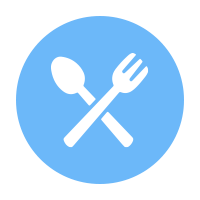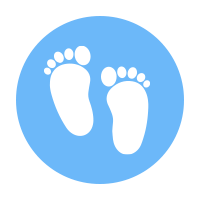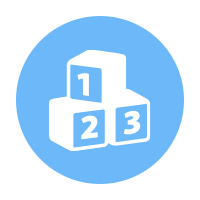12-15 Months:
- Will bite food well.
- Will eat chopped, mashed, grounded food.
- Will use tongues to move food from side to side.
- Will lose a bit of saliva out of the mouth when chewing.
- Occasionally chew with mouth closed.
- Will start to feed themselves with a spoon but will drop some of the food of the spoon.
- Will start to refuse certain foods.
15-18 Months:
- The child is able to support the bowl with one hand while scooping with a spoon.
- Children can hold a small cup and pick out pieces of dry cereal or snacks.
- By 18 months will eat chunky cut food including meat and vegetables.
- By 18 months will drink from a cup without losing liquid from mouth.
- Drinking from a cup can move from a sippy cup to a spouted cup.
- Other young toddlers can drink from a straw.
- Holding the cup moves from a two handed grasp to a single grasp.
By the end of this age range, the 18 month child can hold an open cup on their own to pick up, drink, and set the cup back down with just some spilling of the liquid.
18-24 Months:
- Will know the difference between food and non-food items.
- Will show a clear food preferences i.e. particular likes and dislikes of certain foods.
- Will swallow well from a cup losing no liquid with good lip seal around the cup.
- Will swallow food well without losing food with good lip seal and control.
- Will move jaw in round movements as well as side to side during chewing.
- Will scoop food with spoon with some loss.
- Will start to stab food with fork and bring it to mouth.
- There will be more coordination of the spouted cup or sippy cup and accuracy, with less spillage.
As a child gets closer to two years of age, the variety of foods increases and this allows for greater exposure to textures of foods (mushy, crunchy, etc.) and types of foods (liquids, solid foods, mixed consistency foods).
The child will typically be able to drink from a cup with accuracy and with one hand but with more accuracy and precision. As the child moves toward two years, you can see a desire to drink from an open cup, but the accuracy of motor control and attention skills are not there for this type of cup.
By two years, the toddler can use the spoon to scoop and feed themselves chunkier or thicker foods such as applesauce, mashed potatoes, etc. At this stage, the child will use a dominant hand in self-feeding.
24-30 Months:
- Will know the difference between food and non-food items.
- Will show a clear food preferences i.e. particular likes and dislikes of certain foods.
- Will swallow well from a cup losing no liquid with good lip seal around the cup.
- Will swallow food well without losing food with good lip seal and control.
- Will move jaw in round movements as well as side to side during chewing.
- Will scoop food with spoon with some loss.
- Will start to stab food with fork and bring it to mouth.
- During this stage, the child’s dominant hand is more established
- Typically, the child is able to self-feed without assistance.
- Around 2.5 years, the child can drink from an open cup with one hand. A small, “pixie” cup or slightly larger small cup is great for this.
Between the ages of 2-3 your child will start to eat the same food as the rest of the family. Your child will be able to feed themselves with a spoon and a fork and serve themselves with occasional spills. Your child will have developed definite likes and dislikes and therefore my refuse certain foods.
By the end of this stage, around 3 years, the child can use a fork to pierce soft foods and they can bring the fork to their mouth and remove the food using their teeth and lips.
- Help your child learn to speak. A child’s early words are not complete. Repeat and add to what he says. He may say “ba” for ball and you can say “Ball, yes, that’s a ball.”
- Tell your child the names of objects when he points to them and wait a few seconds to see if he makes any sounds before handing it to him. If he does make a sound, acknowledge him, and repeat the name of the object. “Yes! Cup.”
- Find ways to let your child help with everyday activities. Let her get her shoes to go outside, put the snacks in the bag for the park, or put the socks in the basket.
- Have steady routines for sleeping and feeding. Create a calm, quiet bedtime for your child. Put on his pajamas, brush his teeth, and read 1 or 2 books to him.
- Show your child different things, such as a hat. Ask him, “What do you do with a hat? You put it on your head.” Put it on your head and then give it to him to see if he copies you. Do this with other objects, such as a book or a cup.
- Sing songs with gestures, such as “Wheels on the Bus.” See if your child tries to do some of the actions.
- Let your child use a cup without a lid for drinking and practice eating with a spoon. Learning to eat and drink is messy but fun!
- Use positive words and give more attention to behaviors you want to see (“wanted behaviors”). For example, “Look how nicely you put the toy away.” Give less attention to those you don’t want to see.
- Encourage “pretend” play. Give your child a spoon so she can pretend to feed her stuffed animal. Take turns pretending.
- Help your child learn about others’ feelings and about positive ways to react. For example, when he sees a child who is sad, say “He looks sad. Let’s bring him a teddy.”
- Ask simple questions to help your child think about what’s around her. For example, ask her, “What is that?”
- Give simple choices. Let your child choose between two things. For example, when eating, ask him if he wants the red or blue cup.
- Have steady routines for sleeping and eating. For example, sit at the table with your child when she’s eating meals and snacks. This helps set mealtime routines for your family.
- At 2 years of age, have your child help you get ready for mealtime, by letting him carry things to the table, such as plastic cups or napkins. Thank your child for helping.
- Allow your child to eat as much or as little as she wants at each meal. Toddlers don’t always eat the same amount or type of food each day. Your job is to offer her healthy foods and it’s your child’s job to decide if and how much she needs to eat.”
- Is there anything your toddler does or does not do that concerns you?
- Has your toddler lost any skills he/she once had?
- Does your toddler have any special healthcare needs or was he/she born prematurely?
If your toddler is not meeting one or more milestones, has lost skills he or she once had, or you have other concerns, act early. Talk with your toddler’s doctor, share your concerns, and ask about a developmental screening.
If you or the doctor are still concerned:
- Ask for a referral to a specialist who can evaluate your toddler more.
- If the evaluation still shows concerns call your state Early Intervention program to find out if your toddler can get services to help. Learn more and find the number at Missouri First Steps Program.
- had
What's Next?
Download the Milestone Tracker app today!
Track your child’s milestones from age 2 months to 5 years with the CDC’s easy-to-use illustrated checklists; get tips from the CDC for encouraging your child’s development; and find out what to do if you are ever concerned about how your child is developing. Photos and videos in this app illustrate each milestone and make tracking them for your child easy and fun.













